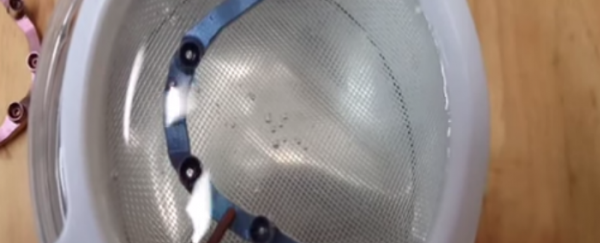
Here's an awesome chemistry assignment you can try at home - turning an ordinary piece of titanium into a technicolour dream… stick of metal. As seen in the video above by YouTuber Debra Adams, all you need to do is submerge some titanium in a liquid solution, and apply a low voltage to it via a crude anode device.
The process is explained in full at the Mr Titanium website, but here's a basic run-down of what you have to do to replicate the above effect:
- Wear rubber gloves so you don't accidentally electrocute yourself.
- Fill a non-conducting tub with an electrolyte solution of either trisodium phosphate, ammonium-phosphate, or Borax. These can all be sourced from your local hardware store.
- Get a piece of scrap titanium and immerse it in your electrolyte solution. This will be the piece you're going to colour, and also your cathode - the part from which the electrical current will leave the device you're constructing.
- Made an anode - a hook or clip made from titanium works well - and attach it to your cathode.
- Apply a small amount of voltage - between 25 and 120 Volts - to your anode, and adjust to get the right colour.
As they explain at the Mr Titanium website, the amount of voltage you use determines the colour you're going to bring out in your titanium, and the results also depend on the size of your titanium piece. "For bigger pieces, it just takes longer. Or more current. Use fuses, an ammeter, and/or a power resistor (or a light bulb in series) to avoid burning out your anodiser," the website explains. "The exact voltage it takes to get a particular colour depends on many variable factors such as free-ion content of the electrolyte, surface finish of the metal, etching, stability of the voltage source, and so on. If you want two pieces to exactly match, anodise them at the same time."
Here's a good rule of thumb for colours and voltages. You'll start to get a faint blue colour at around 10 volts, which will lighten out to a near-white at around 50 volts, and you'll achieve a nice, bright green around 110.
So now that we know how to make metal change colour, you probably want to know the science behind why it occurs.
What we're actually doing when we apply a voltage to the titanium is adjusting the oxide level on its surface. Different levels of surface oxidation achieve different oxide thicknesses, and the colours are achieved when light penetrates through this oxide layer and reflects off the metal surface below, causing our eyes to ultimately perceive a certain colour.
Source: Digg
